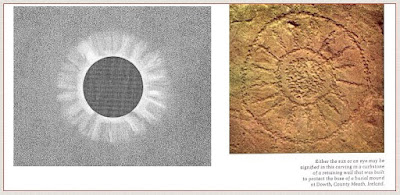Skip to main content
Introducing The Cultural Eclipsology Blog
This introductory "Cultural Eclipsology" post will be expanded and updated over tthe coming days.
The 'Cultural Eclipsology' blog replaces my moribund Eclipsology blog. I am
adding the word "cultural" to "eclipsology" because my primary interest
in eclipses, and my related "eclipsology" research, is regarding how
eclipses, especially total solar eclipses, influenced ancient humanity's
religious beliefs aka mythology, and religious symbolism aka
iconography. "Cultural Eclipsology" is to "Eclipsology" as "cultural astronomy" is to astronomy.
My interest in how eclipses influenced ancient humanity's religious beliefs and symbolism began in the spring of 1992 when I was struck by the similarity of the totally eclipsed sun to the pupil and iris of an eye in French astronomer Serge Koutchmy's photo of the July 11, 1991, total solar eclipse that was published in the May 1992 issue of National Geographic. I noticed the similarity of the total solar eclipse to an "eye in the sky" or "eye of God" immediately upon seeing it in late April 1992. A few weeks later, in mid-May 1992, I noticed the bird-like pattern in the sun's corona that is evident in the same photo, and I immediately intuited that this "sun bird" was almost certainly the original source of inspiration of the Phoenix myth. I did not notice the bird-like pattern in the sun's corona until a few weeks after seeing the photo because the photo was not properly oriented on the two-page spread, and the "wings" of the sun's coronal streamers were in the "gutter". I only noticed the bird-like pattern when I saw the magazine lying open on my coffee table from an angle perpendicular to how it was published.
Subsequent research found plenty of evidence supporting that initial "intuitive flash", and also found a whole flock of other mythical birds and bird gods that were almost certainly inspired by the total solar eclipses. In addition to bird gods and mythical birds, various other winged mythical beings were inspired by the "winged sun" that may be seen during some total solar eclipses, including winged serpents aka dragons. In my initial "Eclipsology" research in the early 1990s I rediscovered British astronomer Edward Walter Maunder's late 19th century hypothesis that the winged sun symbols of ancient Egypt and Mesopotamia were inspired by the bird-like pattern in the sun's corona after noticing similarities between astronomical drawings of 19th century total solar eclipses, perhaps most notably the 1878 total solar eclipse, and the winged sun symbols of Assyria. I first became aware of E. Walter Maunder's theory-hypothesis that winged sun symbols were inspired by, and in some examples quite accurately represent, the bird-like pattern in the sun's corona while reading a book on the "migration of symbols" which mentioned the publication of Maunder's 'An Old Record of the Corona' in Knowledge magazine on January 1st 1897. I later found an earlier publication by Maunder in 'Sunday Magazine' that spoke only of Assyrian winged sun symbols, so it seems Maunder initially perceived the similarity between astronomical drawings of total solar eclipses, and depictions of the Assyrian god Assur aka Ashur in what Maunder describes as "ring with wings" symbols.


Comments
Post a Comment